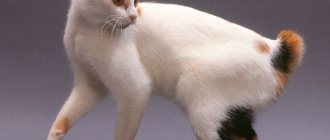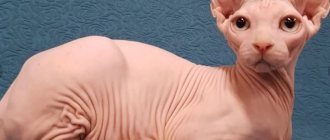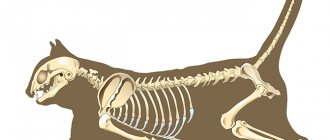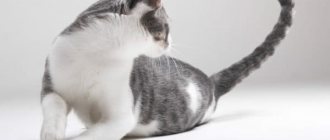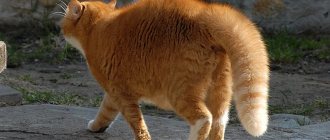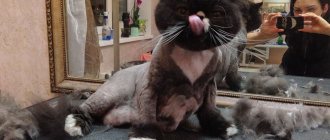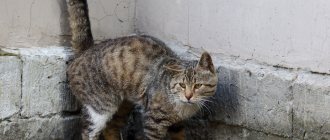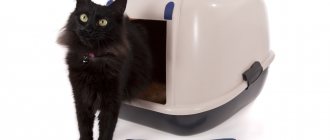The exotic Toy Bob cat is the smallest on our planet. The breed originated in Russia and over the past 25 years has won thousands of fans around the world. The prices are quite high, so not everyone can afford to buy such a pet.
To understand whether this cat is really as good as they say it is, let’s look at the characteristics of its character and the rules for caring for a dwarf cat.
Care and maintenance
For the Kuril Bobtail breed that loves to jump and play, spacious premises are desirable.
A place for sleeping, relaxing and playing is arranged in advance. A multi-tiered play complex with a scratching post and toys is suitable for a cat. Short-haired bobtails are easier to care for than their long-haired counterparts. But basically, maintenance and care are equivalent and consist of the following traditional activities:
Grooming
Short-haired pets should be combed not every week, with a silicone comb, and long-haired pets more often with a slicker brush. Especially on molting days, they use a furminator.
Bathing
Like their ancestors, they love water procedures, but bathe them infrequently when they get dirty or before a cat show. Special shampoos and gels are used for this. Before and after washing, their fur is combed. Dry the cover with a towel or hairdryer.
Ear care
They are examined regularly once a week and cleaned with a cotton swab dipped in ear cleaner to remove the accumulation of dirt and wax. The hair that has grown in the shells is carefully cut off with nail scissors.
Eye care
The eyes are wiped with napkins soaked in “diamond eyes” eye drops, which are intended for animals.
Walks and walks
An active Kuril Bobtail needs fresh air and space so that it can jump, run, and better yet, water bodies where it can splash in the water.
Kurilian Bobtail video
https://youtube.com/watch?v=lbkOUJgP1lc%3F
Diet
What to feed, each owner decides independently, according to opportunity and preferences:
Using professional ready-made food is beneficial for busy people or those who don’t like to cook. The benefit of dosed dry and wet nutrition is that it is balanced in composition, vitamins and minerals. The food is easy to use and has a long shelf life.
Table No3. List of products required in the diet of the Kurilian Bobtail
It is not recommended to include the following foods in the Kuril Bobtail diet:
- vegetable crops such as legumes, potatoes, eggplants;
- meat and other food, but fried and smoked;
- flour products;
- everything is fat;
- chicken tubular bones;
- any sweets and chocolate.
Health and diseases
Kurilian bobtails live at home on average 12-15 years, but there are long-livers up to 18 years. This largely depends on the atmosphere of residence, the quality of care and control of diseases, including genetic ones.
Thanks to the ancestors of the Kuril Bobtails, who lived in the harsh climate of the island archipelago, surrounded by the waters of the Pacific Ocean. Strong immunity was passed on to their descendants; bobtails have excellent health and no predisposition to genetic abnormalities.
As a result of selection and genetic mutations, they have developed certain predispositions to a number of diseases:
- due to hemorrhoids, inflammation of the anus occurs;
- with poor nutrition, intestinal prolapse;
- salt deposits, urolithiasis;
- If the fat balance in food is not maintained, pathological changes in the kidneys are possible.
Experts explain some of the deviations in health by the unusual structure of the short tail.
https://youtube.com/watch?v=HGSJbl1Hd0o%3F
History, character and description of the Skif Toy Bob breed
The history of the origin of the breed began about thirty years ago in Rostov-on-Don, where two Siamese cats gave birth to a strange short-tailed kitten. Despite exactly meeting the parents' standard, it was unusually small in size, which interested the owner. In 1994, the exotic short-tailed breed was officially registered. But it turned out to be more difficult to decide on the exact name - Skif Toy Bob is often also called Skif Tay Don. However, the confusion with the name is easily explained if you know the meaning of the constituent words. “Skif” - in memory of the former population of the territories of Rostov-on-Don, “Don” - in honor of the city where the breed appeared, “Toy” in English means “toy”, “Tai” recalls its origin from the Thai (Siamese) cats, “Bob” is a reference to a short tail like a bobtail.
Photos of cats Skif Toy Bob
Since 2009, the breed has been developed in parallel in Russia and the USA, and the popularity of Toy Bob is only growing. The unusual appearance of the Skif Tai Don cats, the photo of which is presented below, captivates everyone who sees them for the first time. Everyone knows the joy of having a tiny, furry pet at home. But cute kittens grow up quickly, and their charm is preserved only in photographs. Skif Don will never grow up - an adult, fully formed individual of the breed looks like a five-month-old kitten.
Individual weight
Toy Bob's weight rarely exceeds two kilograms. They are trying to make the breed even smaller, so some individuals do not even reach a kilogram of weight. It is rare to achieve results, so the price of Skif Tai Don of such tiny sizes will be very high.
Health
Despite his miniature size, Skif Don has no obvious physique defects. The skeleton of mini-cats is proportional, covered with well-developed muscles. The front legs are slightly shorter than those of the Siamese ancestors, this proportional change is specially maintained. Thanks to his short legs, Ty Bob's gait is a little wobbly, like a real kitten.
Care and care
The most alarming and dangerous period is Toy Bob's childhood. Kittens of this breed are fragile and vulnerable, but at the same time they are highly active and curious, so they often find themselves in difficult situations. The pet's tiny size also makes it defenseless against aggression from other pets. Until Toy Bob grows up, you need to constantly look after him, make sure that the kitten does not climb into a hard-to-reach place or fall from a height.
Photos of kittens Skif Toy Bob
The beautiful appearance of the short-tailed Skif Tai Don is easy to maintain. Short hair does not require complex care or washing; regular brushing during shedding is sufficient. Feeding the smallest cat in the world is no different from the diet of the Siamese ancestors. Skif Toy Bob is unpretentious in his choice of food, so a balanced natural diet or ready-made premium food is suitable for feeding.
Toy Bob: The smallest cats in the world
Recently, the smallest toy bob cats in the world have begun to be bred in Yekaterinburg. A large adult specimen does not exceed the size of a four-month-old ordinary kitten. In one of the Ural nurseries, cat lover Anna Gromova told how toy beans suffer from a “Napoleon complex” and swim in the pool in the summer.
At Anna's nursery we were greeted by two adult animals and two kittens. At first glance, it seems that babies Holly and Toffee are no more than two months old. But we are wrong.
We recommend reading: Neutered Cat Yells Reasons
“They are about five months old now.” Kittens weigh 600 grams. They will grow for up to six months, and then only gain weight. A maximum adult cat can weigh about two kilograms. It is impossible to “fatten” toy beans - this is a common myth, says breeder Anna.
The Toy Bob breed was bred in Russia quite a long time ago, about 30 years ago, in Rostov-on-Don.
— A woman picked up cats on the street. One had a short ponytail with kinks, and the other had a short pom-pom ponytail. They were mated, and a kitten named Kuts was born. It reached a weight of 900 grams, was very small and had a short tail. From that moment on, breeding began. After some time, breeding was stopped and recently resumed only here in Yekaterinburg,” explains Anna.
A cat gives birth to a maximum of three kittens per litter. Due to her size, she won’t be able to bear any more. But females are considered good mothers. They often bite off the kittens' whiskers to prevent the kids from wandering far.
Despite their small size, toy beans are practically fearless. They are difficult to scare off; photographs are mostly taken with their eyes open, and they are not afraid of flash. Toy Bob can be easily taught to follow simple commands, such as fetching a mouse. Small kittens can make sounds similar to a dog barking. Adults are quite silent, except sometimes they can announce their presence to the owner.
- Our male, for example,
could easily bring slippers. Cats are not afraid of water; on the contrary, they love it. They like to swim. In the summer, the toy beans splash around in the inflatable pool in the yard,” comments Anna.
Toy beans are loyal friends. They are attached to people and when “competitors” appear, they conquer territory. This, according to Anya, is a characteristic “Napoleon complex” - cats do not allow their relatives to “look down” on themselves. They practically do not react to birds, domestic rats and dogs.
Toy beans live like regular cats, 15-18 years. They are unpretentious in food. According to Anya, such cats are often purchased by owners of small apartments. Now experts are trying to make the toy bean even smaller and more compact: according to their calculations, soon the weight of an adult individual will not exceed 1200 grams. True, you will have to pay a considerable amount for such a pet - from 25 to 60 thousand rubles.
Feeding the cat
Breeders do not give specific instructions regarding feeding toy bob cats. For these animals, the same diet rules apply as for cats of other breeds.
The main thing is to provide your pet with a balanced diet so that he receives the required amount of protein, vitamins and microelements.
Of the purchased feeds, it is better to give preference to well-known brands:
- Acana;
- RoyalCanin;
- Hills.
And of course, do not forget that the Toy Bob is a small cat, its daily food intake is at least 20% less than that of larger breeds.
Those who prefer to create their own menu for their pet should remember that approximately 80% of the diet consists of lean meat:
- rabbit meat;
- turkey fillet;
- chicken breast;
- veal;
- beef.
The remaining 20% of the Toy Bean cat's diet consists of cereals, vegetables, sea fish, eggs, low-fat cottage cheese, and sour milk. The list of prohibited foods includes sweets, potatoes, processed foods, sausages, salty and spicy foods.
Price skif tai don
Buying a Scythian Tai Don kitten is not a cheap task. The cost of one such kitten will be from 70 to 300 thousand rubles. It all depends on where you are going to buy a kitten, and what class and gender it will be. Girls are always more expensive than boys.
Skif-Tai-Don is a dwarf cat breed, which until recently was only experimental. Its representatives, even as adults, always remain cute kittens. And they are babies not due to shortened legs, like, for example, a munchkin - their body is proportional, only their size is much smaller than that of ordinary cats.
Health
In a global sense, Skif-tay-don has good health and immunity. However, there is one caveat. The breed is experimental, and the breeding program allows mating of Toy Bob, Thai and Domestic cats of a suitable phenotype. That is, hypothetically, a particular Toy Bob kitten may carry the gene pool and, accordingly, hereditary diseases of the “yard Barsik”, if the latter is suitable in size, proportions and color. Infusion of blood from new Siamese cats increases the risk of susceptibility to inflammatory processes in the oral cavity.
Scythian-Tai-Don cat breed
Skif-tay-don (eng. Toy-Bobtail)
Skif-tay-don or Skif-toy-bob, or Skif-tay-toy-don, or dwarf bobtail, or toy bobtail, or Toy-bob is a very rare experimental breed of dwarf cats, rightfully occupying first place in the ranking of the smallest cats of the planet. Outwardly, they are very similar to Thai cats with a short tail.
Appearance of cats of the Scythian-Tai-Don breed.
These cats never grow up and remain like adorable kittens until old age. Even an adult representative of this breed looks like a three to five month old kitten with charming big eyes.
And if you add small weight to the appearance (an adult cat weighs no more than 2 kg), then it will immediately become clear why the word toy was used in the name of the breed.
But, despite their low weight and miniature dimensions, these are muscular, strong and proportionally developed cats.
The body of Toy Bob cats corresponds to the bobtail standard - compact and slightly shortened.
Their front legs are slightly shorter than their hind legs, which is why they have a slightly unsteady gait. The brush is strong, oval in shape, with well-developed claws. The tail can be either straight or curved into a bubo, spiral or tassel; its length does not exceed 7 cm.
The wide head has a wedge shape with neat curves. Cheeks and cheekbones are unexpressed. Their face resembles a Thai cat.
The eyes are expressive and large. The nose is wide and straight. The ears of Toy Beans are close-set, wide, round or pointed in shape with an open ear.
The color of the fur and eyes can be any, the main thing is that they are in harmony with each other (according to the standard). Skif-Tai-Don can be either short-haired or semi-long-haired.
Character of cats of the Scythian-Tai-Don breed.
They become tightly attached to their owner and can twist ropes out of him
Yes, you heard right, these cats have a “cunning trick” in their gene pool - when a cat wants to be paid attention to, it rolls over on its back and begins to meow demandingly, this means: “I want to be held in your arms.”
And, considering that she can sit in your arms for hours, draw conclusions. If you are a busy person, then this cat is clearly not for you. They require increased attention to themselves.
A distinctive feature of cats of the Skif-Tai-Don breed is fearlessness. They are not afraid of anything, neither heights nor dogs. Plus they are completely non-confrontational.
If you are going to buy a kitten of this breed, you need to think about how to protect your ward from other pets (due to their small size they can be attacked), from children (it is difficult for them to fend for themselves).
They never compete for the position of "head" of the territory.
These are silent cats, even during the heat period they do not make a sound.
And if you hear a snort or growl from your pet, it means he wants to attract attention. These cats can also “bark”, making low guttural sounds for entertainment.
Caring for Scythian-Tai-Don cats.
For them, the most important thing is the attention and love of the owner. These cats are painfully lonely
Teach them to a leash and take them for walks, talk to them while you do household chores. If you are free, take them in your arms. The key to a Toy Bean's happiness is to understand that he is loved!
They do not have hereditary digestive problems and easily adapt to any type of diet.
But a balanced diet is important for them due to their small size. This is how the body of any animal works - the smaller the size, the more energy is consumed
They may jump from heights, walk across open fire, or try to chew sharp objects or electrical wires. And given their increased activity and curiosity, they need constant supervision. Remember that the life of this baby is completely dependent on you.
Health of cats of the Scythian-Tai-Don breed.
These cats have excellent immunity and good health at the moment, considering that they are an experimental cat breed.
Mewyyyyyyyyyyyyyyyyyyyyyy love cats
Owner reviews
Owner reviews are overwhelmingly positive. Their impeccable health and extraordinary character leaves no one indifferent who has ever met them. The owners are especially pleased with the silence of this breed. They make any sounds on extremely rare occasions. Even cats behave quietly during the period of sexual desire.
This is an easy-going, soft-tempered pet, with the soulful gaze of large sky-blue eyes . Most children like them and are even used in rehabilitation centers after undergoing special training. Working with children is their calling. These cats do not require privacy, they are not afraid of loud sounds or the screams of children. They will never scratch a baby who is squealing with joy and hugging them.
They are not afraid of the sounds of bursting balloons; these cats themselves fawn to be stroked. These cats help the socialization and adaptation of “special” children. When interacting with toy beans, children loosen up faster and respond to therapy, they make contact more easily, and smiles are more often visible on their faces.
We would like to express our gratitude to the Skif-Toy-Bob cattery “KUTS” for their assistance in preparing this publication.
Return to content
Description of Toy Bean
The main distinguishing feature of Toy Bob will always be his childish appearance. Looking at the blue eyes, small body and short tail, one gets the impression that before one’s eyes is a kitten that has not yet reached the age of six months. The toy bean is smaller than average in size, short and robust in build, with a broad chest and short neck. The muscles are well developed. The back is straight. The limbs are quite strong. The tail is shortened. The maximum body weight of a bob is 2 kilograms. Minimum – 1400 grams. Females are slightly smaller than males, although the sexual dimorphism of the breed is not clearly expressed.
They have medium, strong limbs, oval paws with elongated toes on the hind limbs. The hind limbs are slightly higher than the forelimbs. The toy bob tail is a separate issue. Its length according to the standard should not exceed 1/3 of the body. In some cases, it generally looks like a neat pompom or tassel. The tail can be either straight or with various bends.
The head shape is short trapezoid with softly rounded contours. The chin is strong, the cheekbones are medium and rounded. The nose is of medium length, the bridge of the nose is slightly convex. The ears are medium in size with rounded tips. Standing tall, slightly bent forward.
The most common color is seal point, although there are other variations, but for now this is an experimental version.
Breed standards
A real toy bob should not weigh more than 2 kilograms. The cat's body should be strong and physiologically developed with good pectoral muscles. The head is short trapezoid with softly rounded contours. The eyes are large, wide open, round, very expressive, almost straight set. The color is intense blue.
Toy Bean Character
Little bob tails are brave cats. Kittens of this breed have a pleasant playful disposition. They are funny and kind. They can boast of extreme curiosity, a desire to communicate, while they know how to be calm and show signs of balance. They easily get along with any pets. Children have especially fun with them; who wouldn’t like a kitten who will obediently bring a toy in his teeth? They can be trained.
The Toy Bob is not a useless “miniature cat”, he can be a good hunter. He may not be able to defeat a rat, but he can handle a butterfly, a small mouse or flies with a bang. At the same time, Toy Bob cats do not show signs of aggression. They are extremely socialized. Bob's cat, like a dog, will follow its owner everywhere, he does not have a developed desire to live a detached life, his regime is human-oriented.
Toy Bob coat colors
The most popular Toy Bob coat color is seal point. With this arrangement of shades, the predominant part of the body is painted in a light color, and the ears, paws, tail and muzzle are painted in a darker shade. The colors are combined in a smooth transition.
Mister Cat Recommends: Temperament Features
Miniature Scythians are very funny in appearance and have a courageous and cheerful character.
They are constantly active - both in early and adulthood. These pets simply need a well-equipped corner; it is better to purchase a large complex with poles, ropes and hanging bridges. Otherwise, kids will climb curtains and walls.
It is advisable to have a lot of toys in the house, including rubber ones. That bean can carry them in his teeth all day.
Frankly fearless. Little Skif is not afraid of open fire, loud music, even fireworks.
Smart and smart. Despite his love of hunting for toys and insects, he understands that the parrot is a pet and does not touch it. Makes friends and plays with all animals.
She adores her owner and can sit on his lap for hours, clasping her hand with all four paws. Tai resembles a small lemur. Or he falls on his back and lies under the feet of his household until he is picked up.
The pet is silent and almost never meows. Occasionally makes sounds that are more like a growl or a hoarse bark. And in habits it resembles a dog - it easily gets used to a harness and is able to walk on a leash on the street, loves to bring small objects to its owner and, like a faithful dog, wait for him near the door. He will quickly learn commands - sit, lie down, give a paw.
Even an adult, uncastrated cat has no odor and does not mark its territory.
He plays with children with pleasure and is absolutely non-aggressive.
Buy skif-toy-bob
The strictest control during breeding of cats of this breed dictates its price
It is also important to know that these kittens are not bred at home. Sales are carried out exclusively by specialized nurseries
It will also be interesting:
- Munchkin
- Thai cat
- Japanese Bobtail
- Himalayan cat
Advertisements on the Internet can be placed both by unscrupulous sellers who pass off immature Siamese kittens as toy bobs, and by reputable breeders
And since this breed is quite expensive and rare, special care should be taken not to buy a “fake”, rootless kitten for exorbitant money, which will soon grow to 4 kilograms. The only proof that a kitten has breed standards is documents about its origin
Any self-respecting breeder can provide them to you. And no, even the most persistent and convincing stories can compare with them.
What to pay attention to
When buying a kitten, first of all, you need to ask the breeder to provide all the necessary documents to ensure the authenticity of the breed and the absence of natural developmental defects.
After that, having chosen a kitten, carefully examine it. The baby must be healthy, vaccinated according to age, active, socialized, and look cheerful. Toy Bob kittens are playful and active. The kitten should not have any unnecessary visible discharge; the animal's eyes, nose and ears should be clean. Take the baby in your arms and touch him lightly. The body body should be strong, proportional, the paws should be straight without defects, the belly should be soft and not swollen. The tail may be “twisted” or slightly bent.
Toy bob kitten price
You should be careful when buying a suspiciously cheap kitten. Baby skif-toy-bobs cannot cost less than 70,000 Russian rubles. The cost varies from 70 to 250 thousand rubles. In rare cases, a kitten can cost up to 300 thousand. This is the price they can ask for for a kitten from an elite cattery. The final cost also takes into account the gender, degree of conformity to the breed, weight and character of the animal.
How to choose the right kitten
Those who want to get a Toy Bob cat should contact one of the official nurseries specializing in their breeding. Professional breeders will provide documents that confirm the origin of the animal, as well as veterinary certificates of vaccination.
Important! You should not buy Toy Bob kittens from private individuals who advertise on sites like Avito. There is a great risk of getting a Thai or mixed breed instead of a purebred dwarf bobtail. Animals bred in compliance with all rules are required to be registered with felinological organizations.
Each nursery, and there are not many of them, has its own website, at least one page. There you can find information about the producers and awards of the animals, as well as learn more about the breeder himself and read customer reviews.
The average cost of a Toy Bob kitten in Russia is 70,000 rubles. The price depends on several factors. For example, promising individuals that have every chance of becoming producers in the future are valued more expensive. Pets with minor exterior defects are cheaper.
As dwarf bobtails are rapidly gaining popularity, the demand for kittens is increasing. You should be prepared for the fact that you will have to book your pet in advance and wait several months for your turn.
Origin story
The history of the Scythian Toy Bob breed began in 1983, when Elena Krasnichenko picked up an adult street Siamese cat with a short tail. They called him Mishka. By the will of fate, in 1985, Elena’s mother brought home a cat with the same color and tail, she was named Simka. In 1988, Mikhail and Simka had children.
Among the kittens, one stood out very much; he was the smallest, but at the same time he was not inferior in activity. The baby was named Kutsy. Apparently it was no coincidence that Kutsyy ended up at the first cat show in Rostov-on-Don, the experts examining him whispered for a long time, did not believe that this was an adult cat and called him a mini Siamese.
In subsequent years, Elena Krasnichenko and her mother were actively involved in breeding small cats, and already in 1993, the experimental breed was issued its own certificate number 8 for the registration of an aboriginal Russian cat breed called the Dwarf Bobtail or Toy Bob. Other names for the new breed are Skif-tay-don or Skif-toy-bob.
The homeland of these dwarf, plush toy-like cats is the Russian city of Rostov-on-Don. And the appearance of these creatures can be called a happy accident, like many other exotic breeds.
When Sima grew up, Misha, who lived in the same house with this blue-eyed beauty, could not resist the call of nature, so it is quite natural that within a few months this couple had kittens. Among the babies who looked like their parents, there was one kitten, which was very different from its brothers in its small size and short tail. Elena was puzzled by the appearance of such an unusual kitten, and at first she even feared that the miniature baby would not survive.
The breeder decided to keep this miniature kitten, who received the name Kutsy, and to the great surprise of the breeder, he not only survived, but also began to be actively interested in the opposite sex at the age of one year. Elena realized that she had a chance to breed a cat breed that was incredibly small in size, and she took advantage of it. So a kitten with the funny name Kutsy became the founder of a new breed of cats called Scythian-Tay-Dons.
Already in 1994, the descendants of Kutsego were presented to the world community at the World Exhibition, where these dwarf, toy-like cats created a real sensation among felinologists. In the same year, a description of the breed was made and Scythian beans received official status.
American breeders were so fascinated by these little creatures that at the beginning of the twenty-first century they bought several representatives of this breed with the aim of further breeding them. But in Russia, interest in these cats began to fade and by 2004 there were practically none left. Breeders from Yekaterinburg decided to save the situation and, through joint efforts, were able to revive and increase the population of cats of this breed.
Catering
Scythians are omnivores, so you can feed them both natural and prepared food. But breeders do not recommend a mixed type of nutrition.
Natural products
A natural menu should consist of the following products:
- Lean meat: beef, veal, turkey, rabbit, lamb;
- By-products chicken necks and stomachs, hearts, liver (stewed);
- Sea fish: flounder, hake, trout;
- Porridge: rice, buckwheat, millet, rolled oats;
- Dairy products: kefir, fermented baked milk, sour cream, cottage cheese, natural yogurt;
- Stewed vegetables: carrots, beets, pumpkin, zucchini, lettuce, broccoli, green salad, dill, parsley.
- Clean water at room temperature (it should be changed 2 times a day).
Much from the human table is absolutely unsuitable. Large and small bones (even boiled), fatty foods, foods with dyes and flavor enhancers, sweet, smoked, salty, pickled – the list is long.
Chocolate and eggplants are poisonous; potatoes and legumes cause flatulence and intestinal upset in cats. If you have a question about whether a cat can eat this or that dish, contact your veterinarian for advice.
Recommended food
When choosing industrial ones, stop at food from holistic groups: Applaws, Farmina N&D, Grandorf. Super premium: ProSeries, Savarra, Summit. They are made from high-quality products (meat, fish, vegetables, berries) and contain a complete vitamin and mineral complex, while the premium and economy food lines are of lower quality.
Below are recommended super-premium foods. Links with the names of the food are clickable, on them you can, within our website, get acquainted with the descriptions of the food and read reviews from owners of cats of the Skif Toy Bob breed.
| Holistic | Super premium | Super premium |
| Canagan | Karmy | Pronature Original |
Expert opinion
Dusheba Vera Ivanovna
In 2010, she graduated from the Moscow State Academy of Veterinary Medicine named after K.I. Scriabin with honors, specializing in veterinary medicine. I regularly attend veterinary conferences, congresses, and webinars.
It often happens that under the guise of a Scythian toy bob, scammers sell ordinary Siamese kittens. If you do not have experience in choosing a breed, and you do not know its basic characteristics, do not take risks and do not buy an animal from your own hands. Contact a specialized nursery, which will provide you with all the necessary documents confirming your pedigree and a veterinary passport indicating vaccinations and diseases (if any). The cost of a kitten is high: from 70,000 rubles for a baby “for the soul”, i.e. pet class, and from 250,000 per show class individual.
Description of the breed
A description of the Mekong Bobtail breed should begin with its remarkable coloring, which is very similar to the coloring of the Siamese. But Siamese cats do not have a special distinctive feature of the Mekong, namely a short curved tail. Each cat's fingerprint is unique, just like a person's fingerprint.
Another feature of the Mekong breed: the skin does not fit closely to the animal’s body. This feature is sometimes explained by the fact that the ancestors of the Mekong Bobtail were often forced to fight snakes. And thanks to this structure of their body, snake venom did not penetrate beyond the skin.
This is interesting: the most popular and widespread of the cats with a short tail is the Kurilian Bobtail.
Mekong breed standard
The Mekong Bobtail cat breed is distinguished by its small size (the weight of adult individuals does not exceed 6 kg) and elegant physique. But this external fragility is deceptive, since the body of these cats has powerful muscles and strong limbs of medium height.
The Mekong breed standard includes a number of mandatory conditions:
- The head is round with a clearly defined jawline. Its size is proportional to the body.
- A nose with a hump, or as they often say, a Roman profile.
- The eyes are oval and sometimes slightly slanted. The Mekong breed standard allows only blue eyes, but shades may vary.
- The tail is short and curved. It consists of at least three vertebrae. The length of the tail is no more than a quarter of the body length of the Mekong. The first bend of a purebred representative of the Mekong Bobtail family must begin at the base of the tail. Despite the prejudices associated with the shape of the tail, cats have a well-developed tail, they can even wave it.
- The ears of these cats are set high, wide at the base and with pointed tips.
- The coat is short and soft, with virtually no undercoat.
Kurilian Bobtail - description of the breed
A typical Kurilian bobtail is a hunter cat, whose appearance evokes clear associations with wild representatives of the cat tribe. But the sizes are not particularly impressive: the weight of the cat is 5-7 kg, and the female is even less - 4-5 kg.
Otherwise, a cat of this breed is characterized by:
- Strong, muscular and short body with a slightly arched back and high croup, which resembles a lynx;
- Strong legs, with the hind legs slightly longer than the front ones, and wide round paws;
- Proportional head with rounded triangular outlines;
- Round, dense cheeks and a strong chin;
- Small, spaced ears, rounded at the ends. Tassels are welcome;
- Straight wide nose;
- Eyes set wide apart and slightly slanted, usually yellowish-green in color;
- A tail of 2 - 10 vertebrae, bent in different directions or twisted in the form of a spiral, with a total length of 3 - 8 cm. Looks like a lush pom-pom, thanks to its especially long hair;
- The wool is thin and soft to the touch. In short-haired bobtails, it is correspondingly short on the body, although on the belly and back it is longer and forms “pants.” In semi-longhair - long or medium length, forms a collar and frill on the neck;
- Dense undercoat.
Faults that may cause a reduction in score or disqualification from a show include characteristics that are more common to other breeds and thereby make the boundaries between them blurred.
Disadvantages include:
- Lack of tail;
- A tail whose length is beyond the acceptable limits, as well as short and straight;
- Too massive or, conversely, light body;
- Excessively short front legs;
- Narrow and long head;
- Convex cheekbones;
- A long nose;
- Large and pointed ears;
- Round eyes;
- Lack of undercoat;
- Invalid color.
New photos of dogs
TUESDAY 02/25/2020
| Breed | Irish Wolfhound |
| Dog | Veigari S-2 |
| Nursery | Veigari |
| Announcement | Dogs for sale, No. 15253 |
| Photo | No. 112498; size: 2048 x 1356 |
| Photo gallery | Nursery album |
| Theme gallery. | No |
| Breed | Irish Wolfhound |
| Dog | Veigari S-2 |
| Nursery | Veigari |
| Announcement | Dogs for sale, No. 15253 |
| Photo | No. 112497; size: 2048 x 1356 |
| Photo gallery | Nursery album |
| Theme gallery. | No |
| Breed | Irish Wolfhound |
| Dog | Veigari S-2 |
| Nursery | Veigari |
| Announcement | Dogs for sale, No. 15253 |
| Photo | No. 112496; size: 2048 x 1356 |
| Photo gallery | Nursery album |
| Theme gallery. | No |
How the famous “Scythian-Tai-Don” breed was created
Surely you will be interested to know about the origin of these wonderful cats. Their homeland is Russia, which has a glorious city called Rostov-on-Don. It is known that the smallest cat breed came into existence by an absurd accident, thanks to Elena Krasnichenko. It was she who, back in the distant eighties of the 20th century, took a kitten from the street, which was of a Thai breed. This animal's tail was of an unusual shape, as it had kinks in several places.
This woman, seeing such an interesting and cute kitten, could not leave him on the street. Elena took the foundling for herself and named it Misha. Soon Krasnichenko had a pretty Siamese cat named Sima in his home. The favorite was not very tall and had a short tail. Since the animals lived under the same roof, and the owner decided not to sterilize Sima, kittens appeared after a certain period of time.
Three kittens were born into this cat family, one of which looked like its parents. He was small in size with blue eyes and had a short tail. At first, Elena thought that the pet would not survive, but to her surprise, the kitten grew up to be a good pet named Kutsy.
Character and temperament
The Toy Bob cat has a peaceful disposition; it is an affectionate, gentle and active pet. There is not a drop of aggression or malice in him. He easily finds a common language with other inhabitants of the house - dogs and even large rodents.
According to the creator of the breed, Lyudmila Krasnichenko, the Toy Bob cat has a poorly developed hunting instinct, so it is allowed to be kept together with parrots.
This is a cute, playful and inquisitive pet who is interested in everything that surrounds him - flowers, jewelry, pencils
It is important to hide small objects away so that the cat does not swallow them during play.
Toy Bob cats are sociable and love to be the center of attention. They become very attached to one of the family members and follow on his heels to get their portion of love and tenderness. The pet will willingly participate in all activities, but will never be too intrusive.
Toy Bob is a fearless and very curious cat. She runs with interest to the front door to greet guests. The pet treats strangers without an iota of wariness or fear, sits in their arms and purrs. The Toy Bob's wonderful personality is one of the reasons why this cat breed is gaining more and more popularity.
Education and physical activity
Toy Bob cats are smart and therefore easy to train animals. Typically, kittens come under the care of a new owner already accustomed to a tray and scratching post. This is what breeders do in the nursery.
If desired, the toy bob can be taught to perform simple commands. Many cats of this breed can bring a ball to their owner in their teeth.
When it comes to physical activity, toy beans do not disappoint. They are constantly on the move and need a lot of toys. Kittens love to run, catch string, and also small insects. Your pet will be delighted with the cat complex, where you can climb up, hide in the house and sharpen its claws.
A Toy Bob cat will play with a child with great pleasure and will tolerate even too strong hugs and noise. However, it is worth warning children that the pet may suffer from rough treatment.
Diseases and life expectancy
The immune system is strong and no genetic diseases have been identified. Life expectancy is 20 years, which is quite a lot for representatives of the cat family.
For prevention, it is necessary to be periodically checked at a veterinary hospital. Carefully monitor your pet's condition in order to provide the necessary assistance in a timely manner.
Siamese and Thai cats often have a blockage in their digestive tract due to ingestion of fur when licking. As a result, intestinal obstruction may occur, which is life-threatening for the miniature Scythian. Veterinary pharmacies have special tablets for removing hair from a cat’s body.
Health and susceptibility to disease
The lifespan of toy beans is 15-20 years. The breed was bred recently, so it is still impossible to say with certainty whether it has any specific diseases that are inherited. Breeders claim that their pets are healthy, active and strong.
However, according to other sources, Toy Bob cats sometimes suffer from problems with the joints and spine. Some pets are diagnosed with heart disease, but this happens to other breeds as well.
However, there is nothing to worry about - nursery owners always inform potential buyers about the defects of their charges. If someone wants to buy a cat with disqualifying characteristics, it is sold cheaper.
